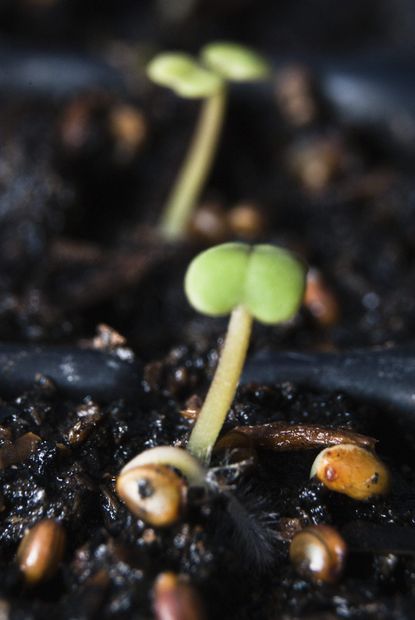Seedling Care Tips: Caring For Seedlings After Germination


It’s that time of year when self-starting gardeners have sown their seeds indoors and are contemplating the next steps. Those tiny little sprouts have shown up and need the best care before their planting out into the world. Care for seedlings once sprouted amounts to more than just giving them water. Healthy, robust plants produce faster with higher yields, which is a winning situation for the gardener. A few tips on how to take care of seedlings should help ensure you bumper crops your neighbors will envy.
Things That Can Kill Your Seedlings
Growing plants from seeds is a rewarding endeavor that reaps big rewards. Caring for seedlings after germination isn’t hard, but attention to such things as damping off, nutrition, temperature, water, light and transplanting will guarantee stout seedlings that survive the rigors of outdoor living. Even the most experienced gardener can benefit from some seedling care tips to boost their success. Those little green shoots poking through the soil send our hearts soaring with thoughts of fresh produce and the joy it brings to our summer entertaining. Damping off is a real threat when caring for seedlings after germination. Just because the seeds managed to sprout doesn’t mean the plants are out of danger. Damping off is a fungal disease that causes the tiny plants to wither and die. It can stem from contaminated containers or soil and is worsened by incorrect watering practices. Use a sterilized soil or soilless mix and wash containers carefully to prevent contaminating the seeds and plants. Keep plants in a sunny location during the day but move them at night to prevent cold drafts from stunting their growth. Too much water can cause tiny roots to rot while too little will see your new babies shrinking and even dying.
How to Take Care of Seedlings
One of the basic seedling care tips is that you don’t need supplemental food until the cotyledon has completely emerged and several sets of true leaves are present. Feeding your new kids too early can burn roots and tender foliage. Seed starter mixes are formulated with all the nutrients your new plants should need until they are planted outside. A soilless-grown crop will benefit from fertilizer diluted by one-quarter once per week. Water your plants when the surface of the soil is dry to the touch. The exact time will depend on how warm the room is and how hot the light. The best temperature for optimum growth is between 70 and 80 F. (21 to 26 C.). Avoid exposing seedlings to temperatures below for more than a few hours and above 100 F. (37 C.), which will stunt root growth. Thin the plants where multiple seeds have sprouted in the same cell or container.
Transplanting and Hardening Off
Successful care for seedlings once sprouted will take you on the road to transplanting. Plants grown in peat cells should receive a new pot that will allow for future growth. You'll know when it is time if you can see roots out of the bottom of the cell. Spoon out the seedlings to avoid damaging the stem by lifting them. Use a good sterile soil again and water them well immediately. You can use any container, but peat pots and other compostable materials allow for easy insertion into the garden bed without damaging roots. As an added bonus, the container will break down and add nutrients to the soil. Hardening off is a step that shouldn't be skipped. This is done before your plants are introduced to the garden bed. Two weeks before planting them outside, gradually introduce your babies to the conditions. Move them outside for longer and longer periods to acclimate them to the wind, light levels, temperature and generally get them used to the idea that they will be outdoor plants soon. This will prevent the stress that is associated with seedling failure after outdoor transplanting. After a couple weeks, plant the seedlings in a prepared seed bed and watch them grow.
Gardening tips, videos, info and more delivered right to your inbox!
Sign up for the Gardening Know How newsletter today and receive a free download of our DIY eBook "Bring Your Garden Indoors: 13 DIY Projects For Fall And Winter".

Bonnie Grant is a professional landscaper with a Certification in Urban Gardening. She has been gardening and writing for 15 years. A former professional chef, she has a passion for edible landscaping.